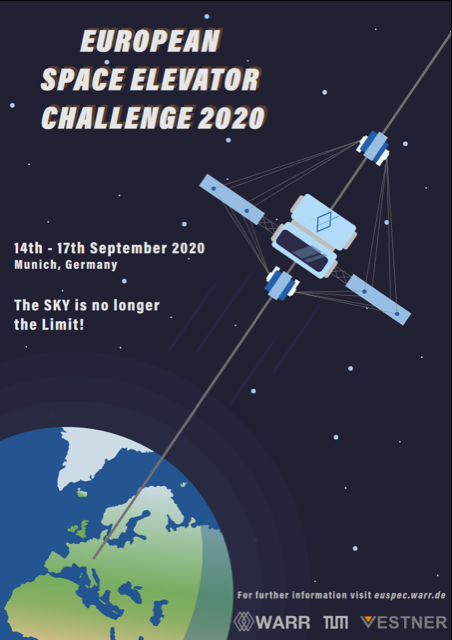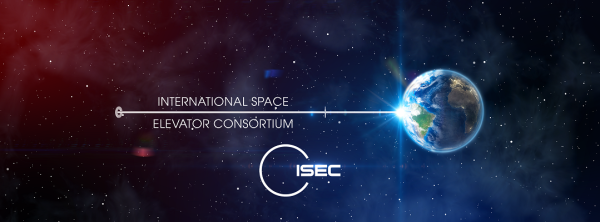|
Welcome to the
March 2020 Edition
of the ISEC Newsletter
In this Issue:
Editor’s Note
President’s Corner
Architecture Note
News from the GEIC
Earth Space Elevator First
European Space Elevator Challenge
Summer Internship
Upcoming Events
Dear Fellow Space Elevator Enthusiast,
Every year at the Space Elevator Convention, we have a presentation called “Space Elevators 101” where the basics are presented in a slide show for the attendees so that we are all starting on the same page. Of all the slides, this is the one that impacted me the most:
Support for Visionaries
“The flying machine which will really fly might be evolved by the combined and continuous efforts of mathematicians and mechanicians in from one million to ten million years”
The New York Times
9 October 1903
(Source: DARPA)
“We started assembly today”
Orville Wright’s Diary
9 October 1903
I know that there are many detractors and naysayers, but we at ISEC fix our eyes on the stars and strive to build a space elevator to help get us there!
Please like us on Facebook, follow us on Twitter, and check in on our website for updates.
Sandee Schaeffer
Newsletter Editor
Home
President's Corner
by Pete Swan
Beneficial Environmental Impacts of Space Elevators
As Michael Fitzgerald is apt to say, "This is the transportation story of the 21st century." Indeed, daily space elevator liftoffs with massive payloads going to GEO and beyond will be remarkable and revolutionize the global transportation infrastructure with its simplicity and benefits. In addition to the normally discussed benefits of reliable, routine, safe, and efficient access to space, its strength of benefiting the environment must also be recognized. Of course - one of the essential strengths of Space Elevators is its ability to improve the Earth's environment through a two pronged approach: (1) enabling missions that are beneficial to the Earth's environment -- such as the replacement of coal plants with space based solar electrical power to anywhere at anytime, and (2) Lifting payloads towards the stars without employing rocket engines for thrust. These strengths lead to the basic question of: how can the characteristics of Space Elevators enable missions of all types, while having little or no negative environmental effects on our planet? Space Elevators will not only lower emissions when payloads are lifted off the surface, but they will allow several missions in space that will improve Earth’s environment. One favorite mission of Mr. Jeff Bezos is to move hazardous manufacture off-planet. This concept will require massive payloads; however, the mission will result in improving the Earth's environment. ISEC is conducting a study to show the beneficial environmental effects of building, and daily use of, Space Elevators and what kind of missions can be accomplished to improve the Earth’s environment. The reality is that as humanity has decided to conduct off-planet activities, there is a tremendous need for logistical support for the movement of supplies and infrastructure with the transportation of people [especially with safe, low cost, and routine or daily liftoffs]. With these tremendous needs of the future goes the responsibility to ensure low environmental impacts while also providing positive environmental benefits from space elevator services.
Home
Architecture Note #30
by Michael A. Fitzgerald
Senior Exec VP and Co-Founder
Galactic Harbour Associates, Inc
Space Elevator Transportation & Enterprise Systems
Personal Prolog
This is an Architecture Note. It is the opinion of the Chief Architect. It represents an effort to document ongoing science and engineering discussions. It is one of many to be published over time. Most importantly, it is a sincere effort to be the diary, or the chronicle, of the multitude of our technical considerations as we progress; along the pathway developing the Space Elevator.
Michael A. Fitzgerald
The Space Mosaic and the Galactic Harbour
I have a very close friend; a retired priest. Yes, a retired one; about as retired as I am. At any rate, my friend is very wise; based on his experiences over the last 50 years or so. His job was saving souls, and he was good at it. About eight years ago, he said something to me that turned out to have a quite an impact. I was engaged in a problem solving study for my Air Force; and was getting frustrated with it. “Michael”, he said; “Stop looking at all those little pieces that are messed up or incomplete. Think about the whole thing – the total mosaic.”
Here I am today, explaining the development process to an incredibly smart group of people who believe fervently that the Space Elevator Transportation System is the answer. What I am finding is that they see it is an answer to a number of different things, would be used by a number of different people, for a number of different purposes. Huh?! The point is that things, people, and purposes are the little pieces in the total mosaic that my retired priest/friend was talking about – the pieces make the mosaic.
Let’s try making some lists, and see what this mosaic of space might be with Galactic Harbours in the mosaic:
Galactic Harbours – as Things
• Space system
• 21st Century Transportation system
• Safe, efficient, reliable departure from Earth
• Interplanetary travel system
Galactic Harbour People
• Astronauts
• Explorers
• Entrepreneurs
• Maintainers
• First Responders
• Government bureaucrats
• Researchers
Galactic Harbour Purposes
• Environmental preservation
• Enterprise
• Humankind’s venue to the solar system
• Mining exotic materials
• Protecting Earth’s Habitat
• Going where no one has
Another impressive list, … still incomplete
There are undoubtedly dozens of additions to each list, and each deserve a discussion about how the Galactic Harbour can assist each of them as they pursue their future. Each are unique, each are essential, each contribute to the Galactic Harbours, and each are members of the Space Mosaic.
In Closing
I can hardly believe just how important this is. Thank you all. Just saying. 
Fitzer
Home
News from the GEIC
The Graphene Engineering Innovation Centre (GEIC, pronounced like ‘geek’)
by Adrian Nixon
This is an extract from the journal about the Orbex space company with their graphene enchanced carbon fibre launch vehicle.
https://orbex.space
.png)
Home
Earth Space Elevator First
by Pete Swan
I have loved the latest looks at the lunar space elevator. Great "big thinking" and good analysis of the numbers. As one who worked on lunar and Martian space elevators concepts, I endorse these studies. We need to keep planning for strengths of long tethers anchored on other space bodies. However:
The First series of Operational Space Elevators must be Earth based to defeat the principal challenge - escaping the Earth's gravity well. The solution is routine, daily, inexpensive, safe, environmentally friendly and massive (14 metric tons per day) delivery to GEO and beyond. The characteristics of Space Elevators need to be executed.
Although the lunar space elevator and Martian space elevators have a tether material presently available, there is no real mission purpose for them until there is massive movement off-planet supplying distributed localized missions. Now that a material for Earth Space Elevator tethers has been shown to exist in the laboratory [single crystal graphene at 0.5 meter length] an Earth based Space Elevator becomes a near-term possibility. “Yes, Graphene tether material really is possible within our lifetimes.” [Nixon, A, “Last Piece of the Puzzle? Graphene,” ISEC webinar, 15 June 2019]
First, build space elevators on Earth, as a complementary lift infrastructure to rockets, and enable the growth of movement off-planet to one that is unstoppable and massive. Then, develop the space elevators on other orbital bodies to receive mission payloads or support missions for those surfaces. I like to think of this approach as a natural growth of transportation infrastructures similar to the historic parallel of bridge development:
As an example, development of railroad infrastructure first "bridged" across major rivers which were close to supplier bases that could deliver materials to build. They then transported the materials and supplies to further distances and crossed smaller rivers reaching further and further with railroad infrastructure enabling growth.
"Major infrastructure at source of supplies FIRST!”
Start local - build outward! Secondary local infrastructures on other celestial bodies will be completed when building supplies and people can be brought by initial major infrastructure enabling escape from Earth's gravity well.
Home
.

Home
International Space Elevator Consortium (ISEC)
Announces a Summer Internship Program
Deadline -- 30 April 2020
ISEC will have an internship program this summer to stimulate research inside the space community with the purpose of improving the Body of Knowledge on space elevators. The expectation is that the intern would work from home, putting in approximately 10 hours a week researching various components of the space elevator while working with an ISEC mentor. The selection will be competitive with the top several gaining internships. The details are as follows:
•Process: Apply, be connected with the appropriate ISEC mentor, select topic of interest, conduct individual research, confer with mentor every two weeks, interview local space professional, summarize research, present to mentor/and-or at the ISEC Conference.
•Who: This program is open to all undergraduate students. The program is best suited to Freshman and Sophomores working in a scientific or engineering field, however students from all areas of study are encouraged to apply as ISEC works on all aspects of the Space Elevator challenge from technical engineering problems to questions of Space law and economics. We will be accepting several interns for Summer 2020.
•Where: the intern will conduct Research remotely with meetings by Skype or equivalent. The internships final meeting will either be over Skype or at the ISEC Conference.
•What: Interns will be researching or assisting with ongoing research of one area of Space Elevator development. Areas of research include Space Elevator History, Materials Applications for Space Elevator tethers, Earth Port infrastructure, and more. Interns will report progress regularly to their mentor and produce a summary of their research, as per agreement between intern and mentor. They will present this research in person, by Skype or through a video. A list of research papers is available on website: www.isec.org
•Benefit: In addition to the unique opportunity to work with leading Space Elevator researchers each intern will be awarded a $500 grant, an ISEC certificate of completion, and a letter of recommendation.
Key Dates:
Application due: April 30th.
Internship period: June 15th - August 15th.
To Apply: Please submit your application and any questions to inbox@isec.org by April 30, 2020.
Your application should include your name, school, year, major [and interests], and a short summary of your interest in ISEC and why you would like to have a career in the space arena (no more than 200 words).
Home
Upcoming Events
International Space Development Conference (ISDC)
https://isdc2020.nss.org/
Thursday, May 28th through Sunday, May 31st, 2020
Embassy Suites by Hilton Dallas-Frisco
Dallas, TX, USA
ISEC will have a Space Elevator track on Thursday starting at 10:00 AM and continuing until 5:00 PM
New Strong Materials for Space Applications
https://www.bis-space.com/2020/02/06/23917/new-strong-materials-for-space-applications
Tuesday, July 7
Graphene Engineering Innovation Centre, (GEIC)
Manchester, UK
European Space Elevator Challenge (EUSPEC) 2020
https://euspec.warr.de/
Monday, September 14 through Thursday, September 17th, 2020
Technical University, Garching Campus
Munich, Germany
Team registration ends April 30th
International Astronautical Congress
http://iac2020.org/
Monday, October 12th through Friday, October 16th, 2020
Dubai World Trade Center
Dubai, UAE
Home
|
